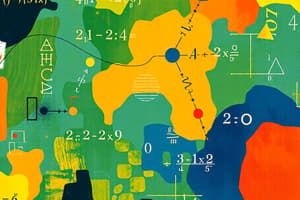Podcast
Questions and Answers
What are variables in algebra?
What are variables in algebra?
- Symbols that represent unknown values. (correct)
- Fixed numerical values used in calculations.
- Combinations of constants and operations.
- Mathematical statements that assert equality.
What is the primary goal when solving an equation?
What is the primary goal when solving an equation?
- Graph the equation accurately.
- Convert the equation into a quadratic form.
- Identify the slope of a linear function.
- Isolate the variable to find its value. (correct)
Which form is associated with linear equations?
Which form is associated with linear equations?
- ax² + bx + c = 0
- y = mx + b (correct)
- y = a(b^x)
- x² - 4 = 0
Which method can be used to solve quadratic equations?
Which method can be used to solve quadratic equations?
What characterizes a function in algebra?
What characterizes a function in algebra?
What is the purpose of factoring in algebra?
What is the purpose of factoring in algebra?
How are inequalities represented?
How are inequalities represented?
What is the result of $x^2 - 9$ when factored using the difference of squares method?
What is the result of $x^2 - 9$ when factored using the difference of squares method?
Which method involves finding points where the graphs intersect?
Which method involves finding points where the graphs intersect?
What is the result of applying the Power of a Power law on the expression $(a^4)^3$?
What is the result of applying the Power of a Power law on the expression $(a^4)^3$?
What does rationalizing the denominator entail?
What does rationalizing the denominator entail?
In the equation $x^2 - 9 = 0$, which method can be used to solve for x using the concept of systems of equations?
In the equation $x^2 - 9 = 0$, which method can be used to solve for x using the concept of systems of equations?
Which of the following is an example of using algebra in real-world applications?
Which of the following is an example of using algebra in real-world applications?
Flashcards are hidden until you start studying
Study Notes
Algebra
Fundamental Concepts
- Variables: Symbols (like x, y) that represent unknown values.
- Constants: Fixed values (e.g., numbers like 3, -4).
- Expressions: Combinations of variables and constants (e.g., 2x + 3).
- Equations: Mathematical statements asserting equality (e.g., 2x + 3 = 7).
Operations
- Addition/Subtraction: Combine or remove quantities.
- Multiplication/Division: Scaling quantities or distributing them.
Solving Equations
- Isolate the variable: Use inverse operations to solve for the unknown.
- Check solutions: Substitute back into the original equation to verify.
Types of Equations
- Linear Equations: Form y = mx + b, where m is slope and b is y-intercept.
- Quadratic Equations: Form ax² + bx + c = 0; solutions found using factoring, completing the square, or the quadratic formula.
- Polynomial Equations: Equations involving terms with variables raised to whole number powers.
Functions
- Definition: A relation where each input has exactly one output.
- Notation: f(x) represents the function evaluated at x.
- Types:
- Linear Functions: Straight line graphs, constant rate of change.
- Quadratic Functions: Parabolic graphs, variable rate of change.
Factoring
- Purpose: Simplify expressions or solve equations.
- Common Methods:
- Greatest Common Factor (GCF): Factor out the largest common factor.
- Difference of Squares: a² - b² = (a + b)(a - b).
- Trinomial Factoring: ax² + bx + c can often be factored into (px + q)(rx + s).
Inequalities
- Definition: Mathematical statements that compare expressions (e.g., x + 3 > 7).
- Solution Set: Often includes ranges of values, represented on a number line.
Functions and Graphing
- Graphing Linear Equations: Plotting points using a table or slope-intercept form.
- Intercepts: Points where the graph crosses axes (x-intercept, y-intercept).
Systems of Equations
- Definition: Sets of two or more equations with the same variables.
- Methods to Solve:
- Graphing: Finding points where graphs intersect.
- Substitution: Solving one equation for a variable and substituting into another.
- Elimination: Adding or subtracting equations to eliminate a variable.
Exponents and Radicals
-
Laws of Exponents:
- Product of Powers: a^m * a^n = a^(m+n)
- Power of a Power: (a^m)^n = a^(m*n)
- Quotient of Powers: a^m / a^n = a^(m-n)
-
Radicals: Expressions involving roots (e.g., √x).
-
Rationalizing: Eliminating radicals from the denominator of a fraction.
Applications
- Real-World Problems: Algebra used in finance (calculating interest), physics (motion equations), and statistics (data analysis).
- Modeling: Creating equations to represent relationships in various contexts.
These notes encapsulate essential topics in algebra, providing a foundational understanding for further study.
Fundamental Concepts
- Variables: Represent unknown values; commonly denoted as x, y.
- Constants: Fixed numerical values, such as 3 or -4.
- Expressions: Combinations of variables and constants; for example, 2x + 3.
- Equations: Mathematical statements that express equality; e.g., 2x + 3 = 7.
Operations
- Addition/Subtraction: Used to combine or remove quantities from expressions.
- Multiplication/Division: Scaling quantities, distributing factors across terms.
Solving Equations
- Isolate the variable: Use inverse operations to determine the value of the unknown.
- Check solutions: Substitute proposed solutions back into the original equation for verification.
Types of Equations
- Linear Equations: Standard form is y = mx + b, representing a straight line where m is the slope and b is the y-intercept.
- Quadratic Equations: Standard form ax² + bx + c = 0; solutions can be derived through factoring, completing the square, or applying the quadratic formula.
- Polynomial Equations: Involve variables raised to whole number powers.
Functions
- Definition: A unique mapping from each input to a single output.
- Notation: f(x) signifies the value of the function f at x.
- Types:
- Linear Functions: Graphed as straight lines with a constant rate of change.
- Quadratic Functions: Displayed as parabolas with variable rates of change.
Factoring
- Purpose: Simplify expressions or solve equations by breaking them down into products.
- Common Methods:
- Greatest Common Factor (GCF): Identify and factor out the largest shared factor.
- Difference of Squares: Format a² - b² = (a + b)(a - b).
- Trinomial Factoring: Express ax² + bx + c as (px + q)(rx + s) where possible.
Inequalities
- Definition: Express relationships comparing values, e.g., x + 3 > 7.
- Solution Set: Often consists of ranges illustrated on number lines.
Functions and Graphing
- Graphing Linear Equations: Use points and slope-intercept form to create accurate graphs.
- Intercepts: Key points where the graph intersects coordinate axes; includes x-intercept and y-intercept.
Systems of Equations
- Definition: Comprise two or more equations sharing variables.
- Methods to Solve:
- Graphing: Visual identification of intersection points in graphs.
- Substitution: Solve one equation for a variable and substitute into another equation.
- Elimination: Combine equations to eliminate one variable and simplify.
Exponents and Radicals
- Laws of Exponents:
- Product of Powers: a^m * a^n = a^(m+n)
- Power of a Power: (a^m)^n = a^(m*n)
- Quotient of Powers: a^m / a^n = a^(m-n)
- Radicals: Involve expressions with roots; for instance, √x.
- Rationalizing: The process of removing radicals from denominators in fractions.
Applications
- Real-World Problems: Algebra is utilized in finance for interest calculations, in physics for motion equations, and in statistics for data analysis.
- Modeling: Creating functions and equations to represent real-life relationships and scenarios.
Studying That Suits You
Use AI to generate personalized quizzes and flashcards to suit your learning preferences.




